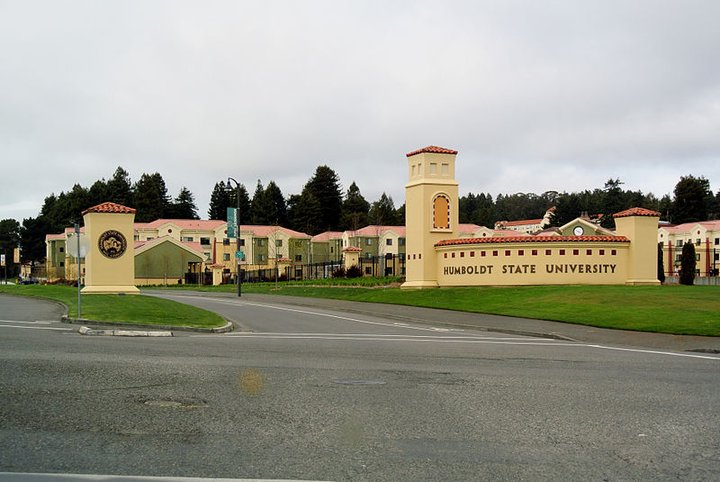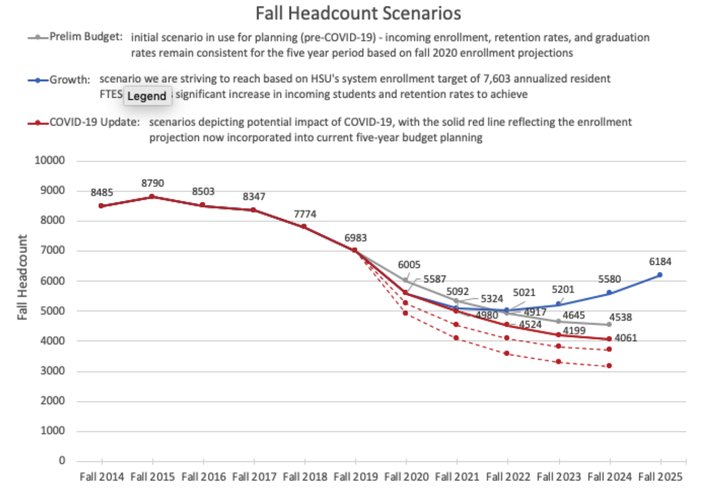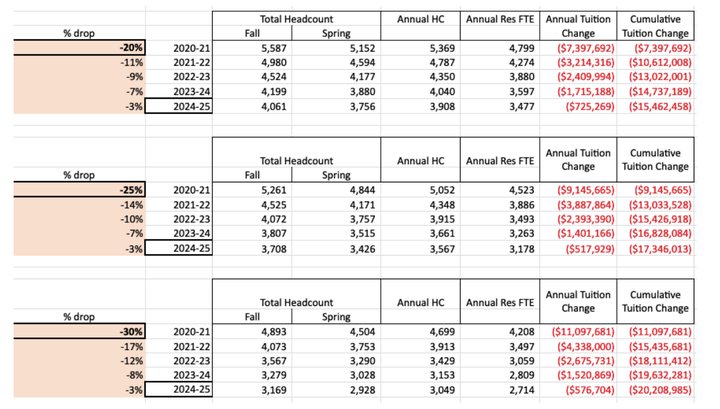
###
Like many other universities across the state and nation, Humboldt State is planning to take a sizable hit to its Fall 2020 enrollment and budget projections due to COVID-19.
In a teleconference meeting held Monday, numerous staff, faculty and members of the public listened and asked questions as Jason Meriwether, vice president of Enrollment Management for HSU, and Doug Dawes, vice president of Administration and Finance, laid out some of the expectations and future shortcomings HSU is expecting — including a 20 percent reduction in total student population.

HSU enrollment projections | Courtesy of HSU
“Everyone wants to know ‘What are you doing with enrollment?’, and there is no benchmark to compare to, and that is creating a lot of angst,” Meriwether said. He then mentioned a Chronicle of Higher Education article that estimated one in every six high school seniors are reconsidering their collegiate plans for Fall 2020. Of those high school seniors rethinking things, 35 percent said they were planning on taking a “gap year.”
“That creates a serious challenge for us,” Meriwether said. “If the CSU is in a recession for enrollment, Humboldt State needs to worry about being in a depression for enrollment. I hate to use those terms, but it just forecasts the impact HSU could face in the terms of COVID-19.”
What this could mean for the university is a drop of about 32 to 39 percent in the incoming Fall 2020 freshman headcount, according to an April 7 report done by Meriwether and other top HSU officials. The effects of COVID-19 on HSU’s freshmen enrollment is expected to have an impact on enrollment for the foreseeable future, and the office is now forecasting the 2024-2025 school year as having anywhere between 3,169 and 4,061 total students.
“If we take such a hit, that could potentially put us in an overall 20 percent reduction in population, which then has a direct impact on the budget,” Meriwether said. The university recently announced it is expecting a decrease of $20 million over the next two years due to COVID-19 as well.

Enrollment scenarios
HSU has already given back over $2.5 million to students due to refunds in housing, meal plans, and parking, and it expects this number to increase as the pandemic drags on.
These unexpected economic and enrollment hits are coming after HSU has made strides at increasing its enrollment numbers. During the teleconference, Meriwether said that on Feb. 25, the university had a 57 percent increase in new student confirmations when compared to the last year’s numbers. However, according to the aforementioned report, the university’s Fall 2020 student enrollment confirmations were up only 12.76 percent on April 7, and that number has now shrank to about 5 percent above last year’s numbers.
“In the COVID-19 world, we have seen a 57 percent growth-point for new students rapidly decline to a five percent growth-point,” Meriwether said. “That is very frightening, because this melt has happened in about a month or less.”
To combat the decline, Meriwether said retention of current students is going to be a key, as will focusing on local students. He said 208 local high school seniors have accepted the Humboldt First scholarship and are admitted for fall enrollment, a dramatic increase in the prior three-year average of only 32 local high school seniors.
“We now have to work extra hard to yield those students because we are seeing many students are deciding to go local,” Meriwether said. “The good news for Humboldt is that we don’t have to say ‘Oh wow locals are important, let’s do all this work.’ We were already working really hard [to get] local students.”
Meriwether also pointed to the Spring Digital Preview Day as a source of optimism. He said over 300 students participated in the event, which was about 200 more than those that attended the in-person event last spring. The plan to retain students and to recruit more will involve more engagement with student mentors, celebrating academic quality, personalized emails, texts, & phone calls, and a social media campaign with a focus on messaging to local students who are back in town from other universities to encourage them to transfer to HSU.
Doug Dawes’ portion of the meeting focused more on the economic impacts the university could be expecting, as well as some of the plans to bridge any economic shortfalls. If HSU’s enrollment is down by the projected 20 percent, then that translates into a reduction of $7.4 million for the upcoming school year, Dawes said. And this doesn’t reflect any reductions in the university’s operating budget that may be due to the state-mandated reductions.
“Potentially, [COVID-19] is going to throw the state into a recession, and we don’t know what the governor will be asking back from the CSU [system],” Dawes said, adding that HSU is expected to lose about $7 million by the end of June. “We are tracking these [numbers] and will be requesting reimbursements to the extent we can from FEMA and other agencies. It is imperative for everyone to understand that we need to quickly reserve resources and to reduce expenditures to get us to a spending more closely aligned to a small student population.”
In order to reach this, Dawes said many options are being explored, such as hiring chills, spending freezes, operational changes, retirement incentives, travel reductions and other measures. He said all cuts and reductions are being done to achieve “fiscal stability for the institution” while keeping students at the forefront of the decision-making process.

Enrollment scenarios and budget impacts
HSU has received $10 million from the Department of Education as part of the recently passed CARES Act. However, half of that money is earmarked for students who are struggling with finances and other side-effects due to COVID-19. One plan is to give every student $1,000 and others include a more means-tested approach.
“If we were to look at different aspects of need, perhaps we do a $1,000 award or a $1,500 to $3,000 award based on need, then that could serve significantly fewer students.” Meriwether said adding that HSU is still waiting on guidance from the Chancellor’s Office about this. “Students will be informed and so will members of the campus community on exactly how we will use those financial aid dollars. But the important thing for us is to get those dollars into students’ hands and to do so quickly.”
Earmarks are also attached to the other half of the $10 million intended for the university. Dawes said HSU is still looking into the best ways to implement this to get HSU on the best financial footing.
During the Q&A portion of the teleconference, a question about HSU’s $6.3 million “rainy day” fund came up. Dawes said the university is looking into spending some of this, but added that $6.3 million “is not even a month’s worth of payroll for our campus.”
“Please know, these are just one-time funds,” Dawes said. “These are not regenerating, so once we spend that $6.3 million it is gone.”
Dawes also addressed the differences between the rainy day fund of $6.3 million and the $62 million reserve fund. The $6.3 million dollars is related to the operating budget and was designated for economic uncertainty. The $62 million fund includes reserves set aside from a variety of departments such as parking, construction and the college of extended education. The housing department was also saving up money to put a down payment on a new project.
“That right there was about $20 million that they were saving up that would really benefit our students,” Dawes said. “So there are a bunch of other entities that are supposed to manage and bring in enough revenue to support themselves. And it is a good thing that housing has this type of reserve to help weather their storms.”
A question about layoffs also arose, and Dawes said the university will try and ensure the people that are employed stay employed by focusing on incentivizing retirements.
“The retirements are going to be something that we will work through before we go to these other options,” Dawes said. “We are looking at a number of different things to reorganize different areas [to] reduce costs and streamline business so we can save money.”
A decision for face-to-face instruction for the fall semester is still up in the air, and HSU is working with many different agencies such as the state government, the CSU system and possibly the federal government. Meriwether said HSU is currently taking its cue from Humboldt County’s Public Health Officer and the county governments.
“There’s a lot that goes into that decision,” Meriwether said. “I think the best thing right now is to get to May, see where the guidance takes us, see where things change and make a decision as quickly as we can.”
CLICK TO MANAGE